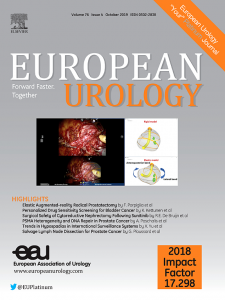一种检测肾细胞癌的新型血浆代谢组学特征的开发和验证
IF 25.2
1区 医学
Q1 UROLOGY & NEPHROLOGY
引用次数: 0
摘要
背景与目的早期诊断是提高肾细胞癌(RCC)生存率的关键。然而,有效的实验室检测仍然缺乏。我们的目标是表征RCC中的代谢重编程,并开发一种用于RCC检测的人工智能(AI)血浆代谢模型。方法在这项多中心诊断模型开发和验证研究中,收集了2019年12月至2023年10月期间来自五家医院的RCC患者和健康对照(hc)的血浆样本。符合条件的患者术前未接受治疗,病理证实为肾细胞癌;hc来自常规体检。排除有恶性肿瘤病史的参与者。非靶向血浆代谢组学通过支持向量机鉴定候选代谢物,并通过高分辨率靶向代谢分析进一步证实。使用选定的代谢物开发了ai辅助诊断模型肾细胞癌人工智能检测器(RCAID),并在六个独立验证队列中进行了验证。进行多组学分析以阐明潜在的代谢机制。主要发现和局限性该研究招募了1680名参与者,包括920名RCC患者和760名hc患者。在RCC病例中,744例(81%)为透明细胞RCC, 633例(69%)为I期疾病。7种关键血浆代谢物,包括2-羟基苯乙酸、壬二酸、N,N-二甲基甘氨酸、N-乙酰-l -天冬氨酸、N-epsilon-乙酰-l -赖氨酸、脯氨酸和(Z,Z)-4-氧-2,5-庚二烯二酸,被鉴定并用于建立raid模型,该模型在训练队列(N = 503)中显示接受者工作特征曲线(AUROC)下面积为0.988。该模型具有良好的诊断性能,在内部(n = 202)、外部(n = 158)、多中心(n = 346)和时间(n = 123)验证队列中的auroc分别为0.977、0.911、0.945和0.972。此外,RCAID在晚期RCC (n = 179)和非透明细胞RCC (n = 169)验证队列中的AUROC分别为0.940和0.932。多组学分析进一步揭示了六种与rcaid相关的RCC代谢失调途径。结论和临床意义本研究确定了RCC的代谢改变,并建立了一种基于人工智能的血浆代谢模型,具有潜在的临床应用价值。本文章由计算机程序翻译,如有差异,请以英文原文为准。
Development and Validation of a Novel Plasma Metabolomic Signature for the Detection of Renal Cell Carcinoma
Background and objective
Early diagnosis is critical for improving survival in renal cell carcinoma (RCC); yet, effective laboratory tests remain lacking. We aimed to characterise metabolic reprogramming in RCC and develop an artificial intelligence (AI)-enabled plasma metabolic model for RCC detection.Methods
In this multicentre diagnostic model development and validation study, plasma samples from RCC patients and healthy controls (HCs) were collected across five hospitals between December 2019 and October 2023. Eligible patients had pathologically confirmed RCC without prior treatment; HCs were recruited from routine physical examination. Participants with a history of malignancy were excluded. Untargeted plasma metabolomics was conducted to identify candidate metabolites via a support vector machine, further confirmed by a high-resolution targeted metabolic analysis. An AI-aided diagnostic model, Renal Cell Carcinoma Artificial Intelligence Detector (RCAID), was developed using selected metabolites and validated in six independent validation cohorts. Multiomic analyses were performed to elucidate the underlying metabolic mechanisms.Key findings and limitations
The study enrolled 1680 participants, comprising 920 RCC patients and 760 HCs. Among RCC cases, 744 (81%) had clear cell RCC and 633 (69%) had stage I disease. Seven key plasma metabolites, including 2-hydroxyphenylacetic acid, azelaic acid, N,N-dimethylglycine, N-acetyl-L-aspartic acid, N-epsilon-acetyl-L-lysine, proline, and (Z,Z)-4-oxo-2,5-hetpadienedioic acid, were identified and used to develop the RCAID model, which demonstrated an area under the receiver operating characteristic curve (AUROC) of 0.988 in the training cohort (n = 503). The model exhibited excellent diagnostic performance, with AUROCs of 0.977, 0.911, 0.945, and 0.972 in the internal (n = 202), external (n = 158), multicentre (n = 346), and temporal (n = 123) validation cohorts, respectively. Additionally, RCAID achieved an AUROC of 0.940 in the late-stage RCC (n = 179) and 0.932 in the non–clear cell RCC (n = 169) validation cohorts. Multiomic analyses further revealed six RCAID-associated dysregulated metabolic pathways in RCC.Conclusions and clinical implications
This study identified metabolic alterations in RCC and developed a promising AI-based plasma metabolic model with potential clinical application for RCC diagnosis.求助全文
通过发布文献求助,成功后即可免费获取论文全文。
去求助
来源期刊

European urology
医学-泌尿学与肾脏学
CiteScore
43.00
自引率
2.60%
发文量
1753
审稿时长
23 days
期刊介绍:
European Urology is a peer-reviewed journal that publishes original articles and reviews on a broad spectrum of urological issues. Covering topics such as oncology, impotence, infertility, pediatrics, lithiasis and endourology, the journal also highlights recent advances in techniques, instrumentation, surgery, and pediatric urology. This comprehensive approach provides readers with an in-depth guide to international developments in urology.
 求助内容:
求助内容: 应助结果提醒方式:
应助结果提醒方式:


